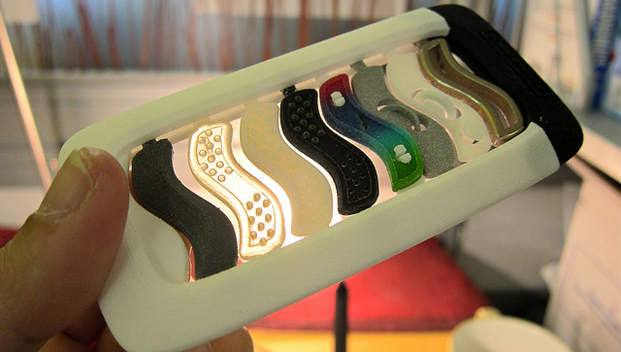If there is one aspect that sets apart 3D printing from other forms of manufacturing, then it is variety of materials that can be printed upon. A single 3D printer can print on multiple materials to create multiple types of objects. In traditional manufacturing, for each type of material a different machine is required, not so in the case of 3D printing. The materials available for 3D printing have evolved a lot in the last few years. Different kinds of materials are developed for different printing technologies namely powder, filament, granules, fillets, resin and so on. Also, at the industrial level there are very specific materials created for highly specific purposes. All this led to a wide variety of materials that can be 3D printed upon. In this article we shall look into the few commonly used materials for 3D printing.
Plastics
Plastics are one of the most commonly used materials for 3D printing, in particular for FDM technology based 3D printing which has become the most popular technology these days. Plastic material is available both in powder form and filament form. Powder form plastic is used for sintering process (mainly SLS) and filament form is used for FFF process (also called FDM process).
There are two types of plastics commonly used for FDM technology based 3D printing. One is ABS (Acrylonitrile Butadiene Styrene) and other one is PLA (Polylactic Acid). ABS is strong, flexible and durable. It is generally used for printing objects with curved edges. It is not so well suited for sharp edges. PLA is ductile and is well suited for sharp edges. ABS is naturally white in color but using various dyes during the filament extrusion process, various colored ABS filaments can also be created. ABS can be mixed with powdered aluminum to produce another common 3D printing material for sintering – Alumide. PLA is a bio-degradable plastic material that has gained wide acceptance within 3D printing community primarily because of its environmental friendliness. It can be used in resin format for DLP/SL processes as well as in filament form for the FDM process.
There are various other types of plastics developed by mixing plastic with other materials. These include LayWood – a wood/polymer composite, PET-G, HIPS, Nylon, PVA and so on. Plastics proved a low cost material to 3D printed on. With lot of research going on in the plastics for 3D printing area we shall be observing lot more developments in this area.
Metals
Metals are another popular set of materials used for industrial grade 3D printing mainly for the material strength and durability. Two most common metals are aluminum and cobalt derivatives. Stainless in powder form is the most commonly used metal for 3D printing. It is used in Selective Layer Sintering (SLS), EBM (Electron Beam Manufacturing) processes primarily. Titanium is one of the strongest metal materials that has been used for 3D printing applications. There is lot of news coverage on how titanium is used to create a skull of human beings in medical field.
As with plastics, there is extensive research going on in metals space to come up with new metals to print on. Disadvantage with plastic is that it can’t be used for end product at the industrial level. The application of plastic is mainly limited to creation of prototypes. But with metals that issue can be resolved.
Ceramics
These days we are hearing quite a bit about Ceramics. Ceramics are a new group of materials developed for 3D printing. But as with traditional manufacturing process, 3D printed ceramics also have to go through firing and glazing before the products can be used for end purpose.
Paper
Paper (Standard A4 paper commonly available in the market) is another interesting yet highly affordable material used for 3D printing. A company called Mcor Technologies has built a proprietary process that uses paper for 3D printing. The concept is loosely based on LOM (Laminated Object Machining). 3D printed models made with paper are safe, environmentally friendly, easily recyclable and require zero post processing.
Food
Off late, we are hearing quite a lot about 3D printed food. With the launch of paste extruder, it has become very easy to 3D print different kinds of food. Chocolate (due to its properties) has become the most common food item to be 3D printed upon. But there are also printers that work with sugar and various experiments are done with pasta and meat. Food remains the most popular material to 3D print on and various new food materials continue to evolve over time.
Bio Materials
There is a lot of research being conducted into the potential of 3D printing bio materials for a host of medical applications. 3D printed kidney, 3D printed ear tissue and all such products come under this category. Lot of research is being conducted on living tissue at various leading institutions. The idea is to 3D print human organs for transplantation and also for replacement body parts. If this proves successful, this is going to revolutionize the entire medical industry.
Others
The above mentioned materials are the most popular materials in usage now. Otherwise there are many more materials under research and development by various companies. Stratasys is one such company that has a unique & proprietary material offering. It offering a varied set of materials which can be mixed in differing proportions to create new set of materials with unique properties. Up to 140 digital materials can be realized from combining these primary materials in different ways.
Summing it all, materials hold a very prominent place in 3D printing industry. As the industry evolves and as the R&D matures, many new materials emerge. There is a huge scope for innovation in 3D printed materials space and lots of funding is flowing into 3D printed materials space.
